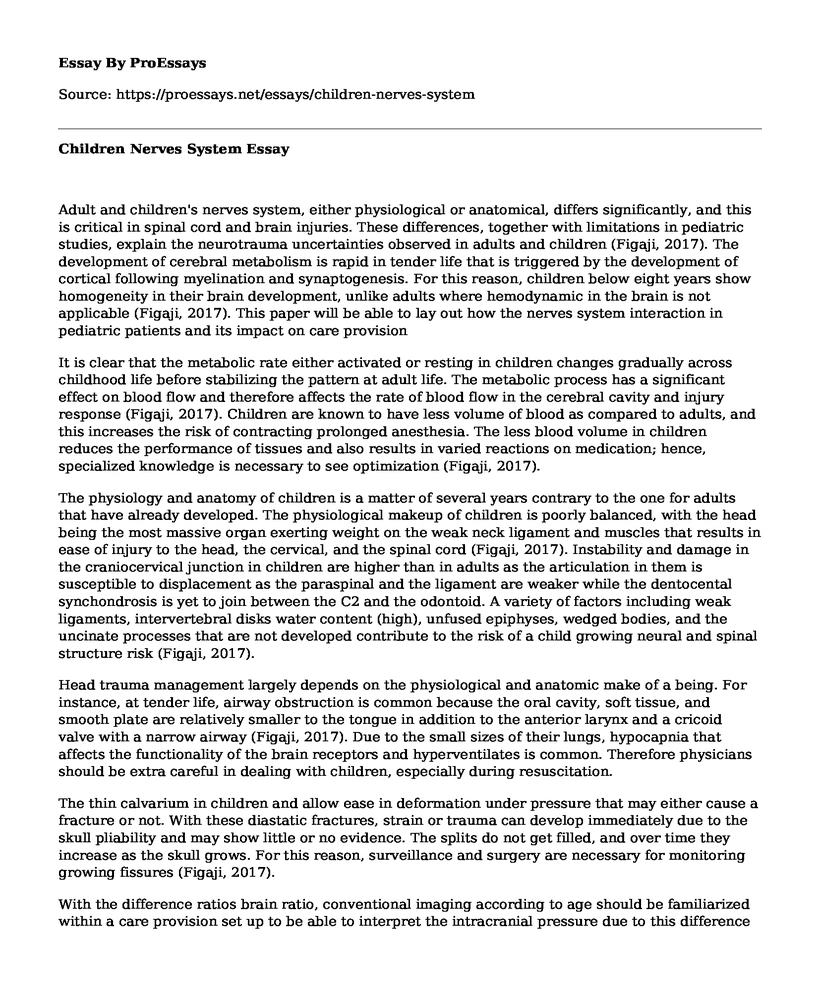Adult and children's nerves system, either physiological or anatomical, differs significantly, and this is critical in spinal cord and brain injuries. These differences, together with limitations in pediatric studies, explain the neurotrauma uncertainties observed in adults and children (Figaji, 2017). The development of cerebral metabolism is rapid in tender life that is triggered by the development of cortical following myelination and synaptogenesis. For this reason, children below eight years show homogeneity in their brain development, unlike adults where hemodynamic in the brain is not applicable (Figaji, 2017). This paper will be able to lay out how the nerves system interaction in pediatric patients and its impact on care provision
It is clear that the metabolic rate either activated or resting in children changes gradually across childhood life before stabilizing the pattern at adult life. The metabolic process has a significant effect on blood flow and therefore affects the rate of blood flow in the cerebral cavity and injury response (Figaji, 2017). Children are known to have less volume of blood as compared to adults, and this increases the risk of contracting prolonged anesthesia. The less blood volume in children reduces the performance of tissues and also results in varied reactions on medication; hence, specialized knowledge is necessary to see optimization (Figaji, 2017).
The physiology and anatomy of children is a matter of several years contrary to the one for adults that have already developed. The physiological makeup of children is poorly balanced, with the head being the most massive organ exerting weight on the weak neck ligament and muscles that results in ease of injury to the head, the cervical, and the spinal cord (Figaji, 2017). Instability and damage in the craniocervical junction in children are higher than in adults as the articulation in them is susceptible to displacement as the paraspinal and the ligament are weaker while the dentocental synchondrosis is yet to join between the C2 and the odontoid. A variety of factors including weak ligaments, intervertebral disks water content (high), unfused epiphyses, wedged bodies, and the uncinate processes that are not developed contribute to the risk of a child growing neural and spinal structure risk (Figaji, 2017).
Head trauma management largely depends on the physiological and anatomic make of a being. For instance, at tender life, airway obstruction is common because the oral cavity, soft tissue, and smooth plate are relatively smaller to the tongue in addition to the anterior larynx and a cricoid valve with a narrow airway (Figaji, 2017). Due to the small sizes of their lungs, hypocapnia that affects the functionality of the brain receptors and hyperventilates is common. Therefore physicians should be extra careful in dealing with children, especially during resuscitation.
The thin calvarium in children and allow ease in deformation under pressure that may either cause a fracture or not. With these diastatic fractures, strain or trauma can develop immediately due to the skull pliability and may show little or no evidence. The splits do not get filled, and over time they increase as the skull grows. For this reason, surveillance and surgery are necessary for monitoring growing fissures (Figaji, 2017).
With the difference ratios brain ratio, conventional imaging according to age should be familiarized within a care provision set up to be able to interpret the intracranial pressure due to this difference (Figaji, 2017). Therefore clinicians should be able to fully understand all the components of a pediatric patient owing that the nervous system is so complex and any alteration at any stage in life affect the general body function, and in doing these, pediatric nerves system risks management can be dealt with.
Reference
Figaji, A. A. (2017). Anatomical and physiological differences between children and adults relevant to traumatic brain injury and the implications for clinical assessment and care. Frontiers in neurology, 8, 685.
Cite this page
Children Nerves System. (2022, Mar 10). Retrieved from https://proessays.net/essays/children-nerves-system
If you are the original author of this essay and no longer wish to have it published on the ProEssays website, please click below to request its removal:
- Anatomy Essay Example on Human Muscles
- The Ethical Issues of Gene Editing Technology: CRISPR/ Cas 9 System
- Connecting Medical Approaches to the Brain Functions - Essay Sample
- Genetics in Treating and Developing Cancer Paper Example
- Essay Sample on Classifying Birds: Habits, Habitats & Adaptations
- White River Forest: A National Reserve Since the Late Eighties - Research Paper
- Silviculture: Art & Science of Growing Sustainable Forests - Essay Sample







